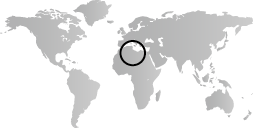At the beginning of the nineteenth century, the Ottomans maintain nominal control over their provinces of Tunisia, Algeria, Libya, and Egypt, though local dynasties continue to hold power in day-to-day affairs. Most prominent is the ruler Muhammad ‘Ali in Egypt (r. 1805–48), who secures the right to hereditary rule for his family and maintains a semi-autonomous status which lasts until 1882, the date of the British occupation. Muhammad ‘Ali initiates a series of military, economic, and administrative reforms, relying on the expertise of French and Italian advisors. He intends to build Egypt into a modern state. These reforms are followed by legal and educational transformations under Isma‘il Pasha, better known as Khedive Isma‘il (r. 1863–79), and modeled on the reforms implemented by the Ottoman rulers in Istanbul. Muhammad ‘Ali demonstrates an interest in the arts and sends educational missions to Europe to learn engraving, painting, and sculpture. Upon their return, these students teach at the technical schools. He also employs Western architects to erect buildings in Cairo in the Europeanizing style. At this time, European Orientalists including Eugène Fromentin, John Frederick Lewis, and Jean-Léon Gérôme visit Egypt. Under Khedive Isma‘il, Egypt becomes virtually independent of the Ottoman empire. With the opening of the Suez Canal in 1869, exposure to Western culture increases. The khedive invites the emperor of Austria, Empress Eugénie of France, the crown prince of Prussia, as well as writers and artists such as Théophile Gautier, Émile Zola, and Henrik Ibsen to the opening ceremonies. He inaugurates an Opera House in Cairo in the same year and commissions sculptors to create large-scale public works of himself, the princes, and elites in Cairo and Alexandria. He also orders European-style paintings for the urban and rural palaces. Isma‘il builds an elaborate compound for the Paris Exposition of 1867; a strong presence at the 1873 and 1878 world’s fairs in Vienna and Paris follows.
The kings of the ‘Alawid/Filali line continue to rule independently in Morocco. Morocco is the only North African country that was neither conquered nor governed by the Ottomans. As an independent state, its power is divided between sultans in urban areas and tribal and Sufi leaders in the countryside. As European trade increases, Moroccan industries cannot compete with those of Europe, and the opening of the Suez Canal and French expansion into West Africa make the trade routes through Morocco obsolete. Sultan Hasan ibn Muhammad (r. 1873–94) introduces military, administrative, and infrastructural reforms, but these prove unsuccessful due to strong opposition by religious and political elites, thus paving the way for French colonization between 1899 and 1912. Moroccan presence at the world’s fairs is modest. Morocco preserves its own distinct Berber tradition until the French colonize it. European expansion instigates a growing interest in North African culture. Several Orientalist painters come to Morocco, the most renowned being Eugène Delacroix, who visits in 1832.
Between 1832 and 1890, the French gradually take control of Algeria. Despite a number of uprisings and sporadic revolts, Algeria is incorporated into France, its administration reorganized and a new educational system introduced. Eugène Delacroix visits Algeria in 1832 and a number of French Orientalists follow in his footsteps. As a result, European easel painting is introduced and artistic societies are founded. In the second half of the century, French Impressionists, including Monet and Renoir, visit Algeria. The most important French artist to influence the beginning of Western art in Algeria is Alphonse-Étienne Dinet (1861–1929). Algeria’s presentation at the world’s fairs is elaborate.
Tunisia also attempts a series of Westernizing reforms modeled on those of Muhammad ‘Ali of Egypt. These are launched by Ahmad Bey (r. 1837–55) and Khair al-Din (r. 1873–77), who also arrange displays at the 1867, 1878, and 1889 world’s fairs. French involvement in Tunisian affairs increases as Tunisia modernizes. The French eventually occupy Tunisia in 1881. During the occupation, the French authorities found the Institut de Carthage, which becomes the leading scientific and cultural institution in the colony. In 1894, the Institut de Carthage organizes the first Salon Tunisien in Tunis. In the next century, Libya, too, will fall into European hands.


